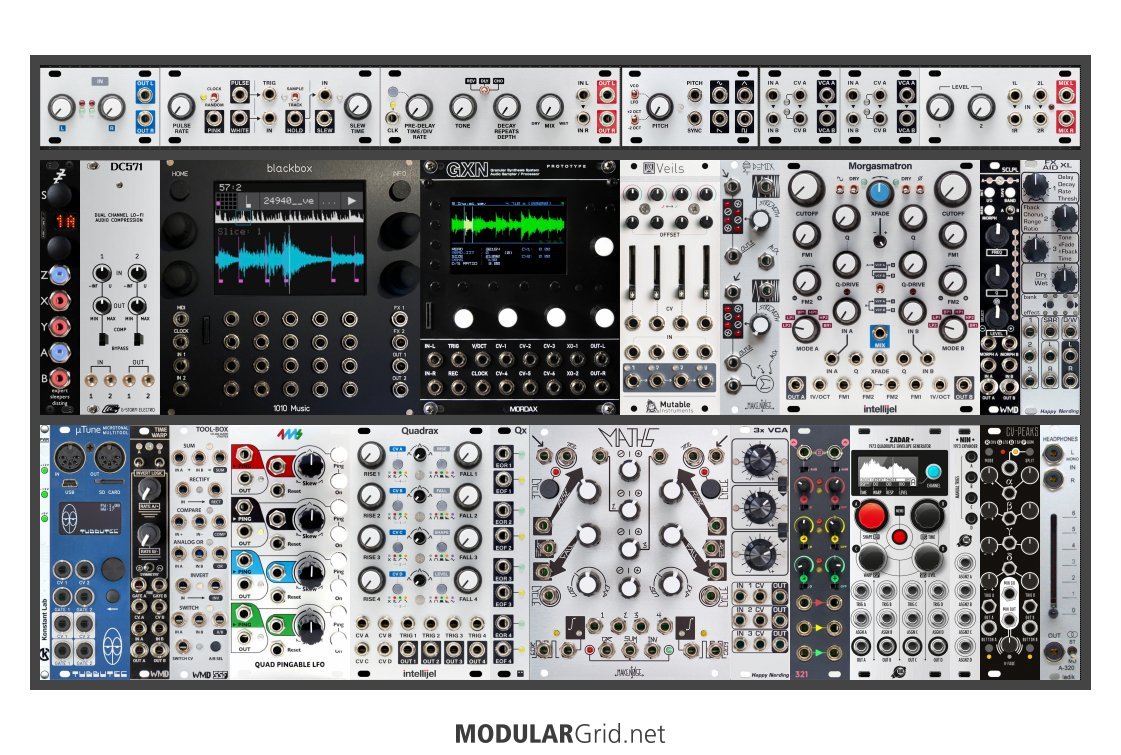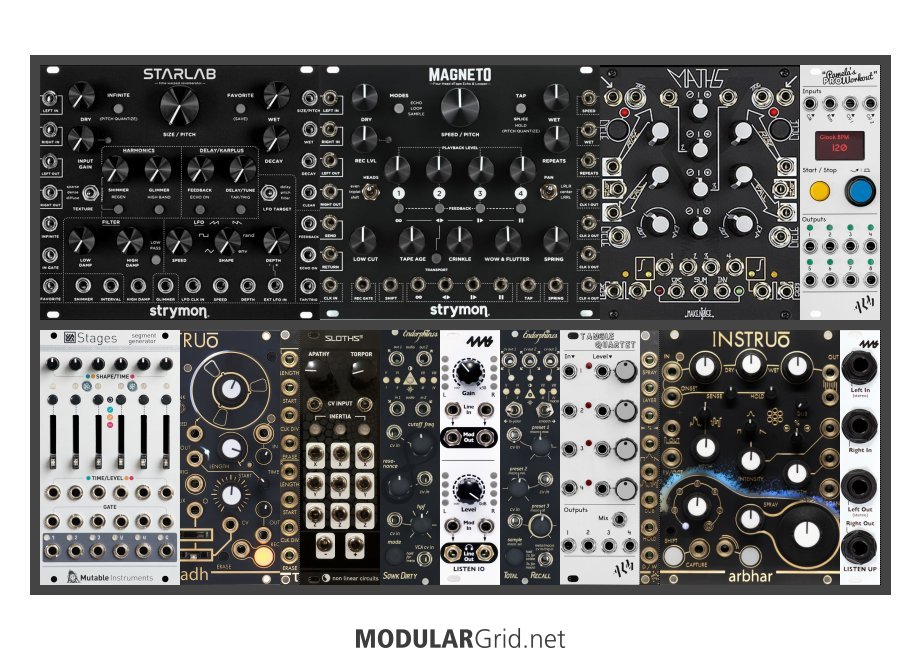One of the biggest issues I have with small skiff builds is that they require lots of compromises. So, I instead opted to show what you'd get if you started in a 7U Intellijel cab, with both granular and sample modules being WAY more beefy as well as easy to operate...especially live. There are compromises here, too...but far less, plus some interesting opportunities popped up.

Now, check THIS out! Same idea, but with a much better powered cab with more space for modulation schemes that the 84 hp skiff simply cannot accommodate.
Tiles: First up is a stereo input control. This gets signals from a pair of the four 1/4" jacks built into the cab. Then I added a Noise Tools tile to give you a clock source, sample and hold, slewing and noise. Next up is a mono-to-stereo effects processor that offers reverb, delay, and chorus. And then, a VCO...but we'll get to that in a bit. Then two stereo VCAs for level control over the input pairs to the stereo mix out...which is also connected to a 1/4" jack pair but ALSO, the on-panel L-R out remains hot. Something else we'll get to in a bit...
Top row: Disting. Then a stereo compressor, which you'll find useful for mildly squishing the audio TO the sampler so that your samples can maintain a degree of dynamic similarity. And as for the sampler, I swapped the Instruo one for a much easier to use (thanks to its touchscreen) Blackbox. Similarly, I swapped out the other Instruo granualizer for a Mordax GXN...for pretty much the same reasons. Whenever you're screwing around with samples, etc, it's SUPER useful to have modules with screens so that you can get a better editing and/or audio control going on than with ones that don't have that. After those, a Veils allows you to either mix the two sources together in stereo, or you can use them as a pair of stereo VCAs per each source.
Now...remember that VCO? The next thing here is a Make Noise modDemix, which is a dual balanced modulator, and that VCO is for splitting across the carrier (via a mult widget...there's no mults onboard, which is about right for something this small, plus you don't "rob space" for a mult or two) inputs so that you can ring modulate in stereo. Next, Intellijel's awesome and super-versatile stereo VCF, the Morgasmotron, and this is followed by the SCLPL for further timbral strangeness. Then, last up you've got an FX Aid XL for more "global" processing. Also, this could be implemented by sending its wet output to one dual VCA and then to one stereo pair on the Stereo Mixer, giving you a parallel processing possibility.
Bottom row: Yeah, this is the seriously new...and VERY needed...modulation row. On the left, the little white sliver is a Konstant Labs PWRchekr to keep an eye on your DC rail health. Then the Tubbutech gives you both a MIDI interface AND a microtonal-capable quantizer. And yeah, even with no sequencer, you can STILL do all sorts of pitch trickery by clocking the quantizer and then feeding it an LFO. Plus, the Tubbutech gives you MIDI over USB and the ability to store configurations via micro SD. Next is the Time Warp, made even more useful now thanks to that stereo input tile. After that is SSF's brilliant utility "one-stop", the Tool-box, giving you a bunch of needed functions that were missing before.
The Ochd got flipped for a QPLFO from 4ms. This has four independent LFOs that are tap-timeable but which ALSO have utterly insane frequency ranges...like, say, as slow as 70+ MINUTES per cycle! And they can go up into the lower audio range, too. Then for CVable rise/falls and also cascadeable looped envelope gens, I dropped in a Quadrax and its Qx expander, which allows the cascading thanks to its EOR/EOF trigger outs. But you can also tie them into the Maths, too, and make things REALLY over the top. And hey, lookit...there's a Maths! A 3xVCA gives you dedicated linear VCAs for modulation level control, and a Frap 321 next to it is there for even MORE modulation scrambling via offset generators and several other odd things.
Then for more complex envelopes, the Zadar and Nin give you four plus a little extra control via the Nin. But if you need to tweak envelopes on the fly, I put in a Paratek CVable Dual ADSR for a total of six (and actually ten if you count the Quadrax) full-on EGs. And...a headphone preamp; remember that "hot output" on the Stereo Mixer tile above? You can connect the tile's on-panel outs to the headphone preamp, and you'll STILL get your output pair on the cab's 1/4" jacks.
Now THIS is a hellacious sound manipulation machine! The control level over the upper audio row is pumped up to INSANE levels via the new modulation row, plus you get a few neat extras via the tile row. Lots of trickery going on in this now...



